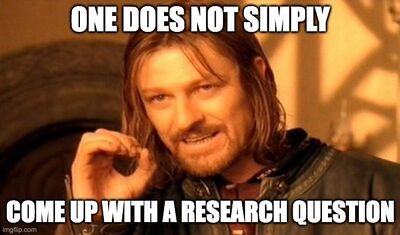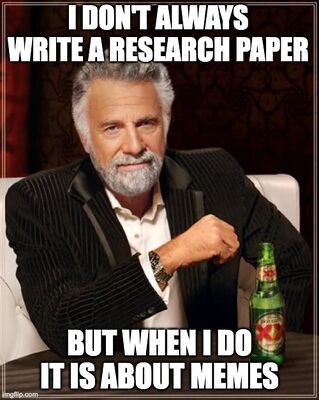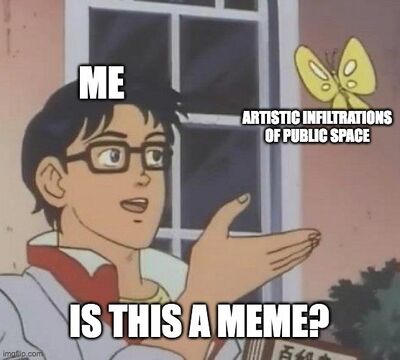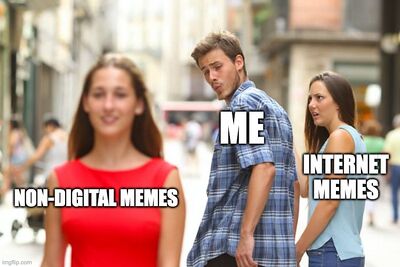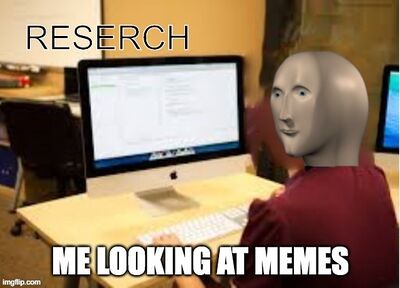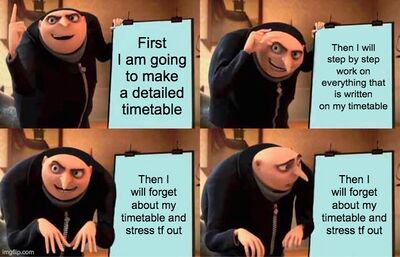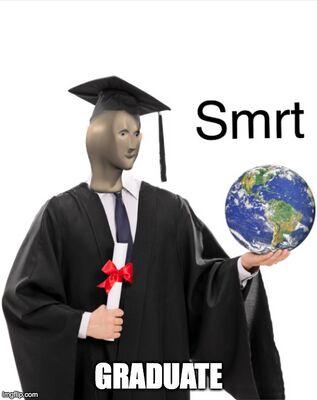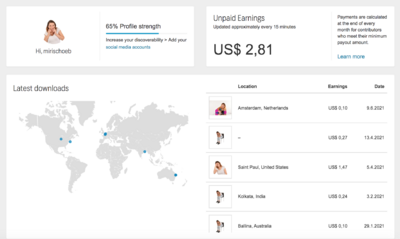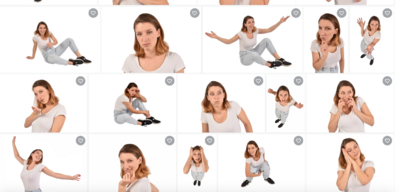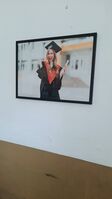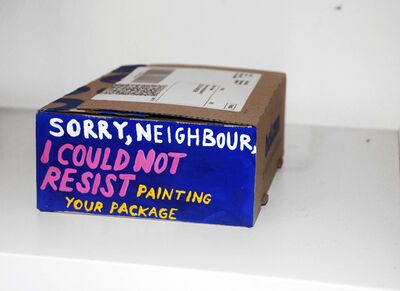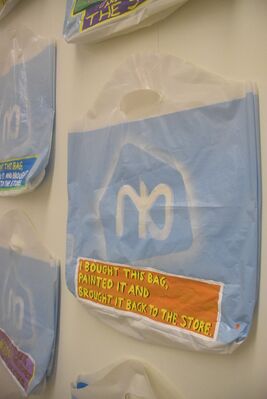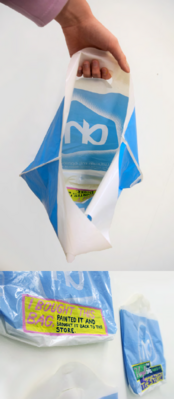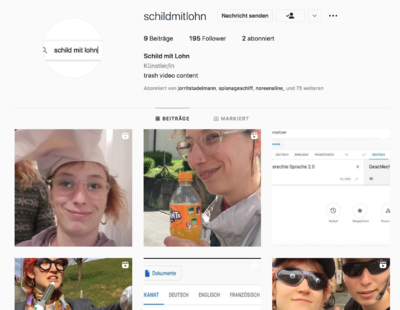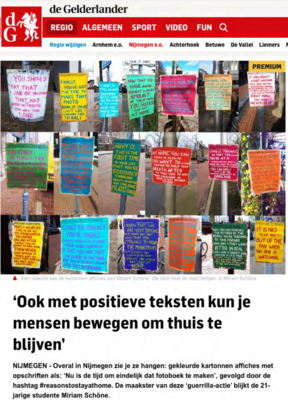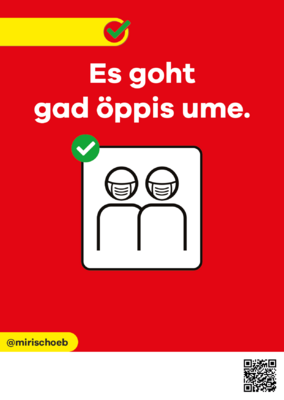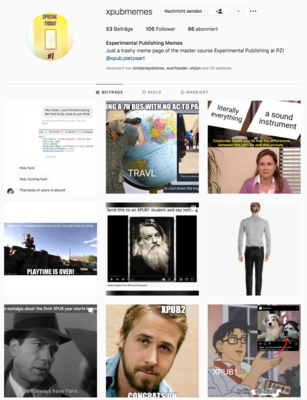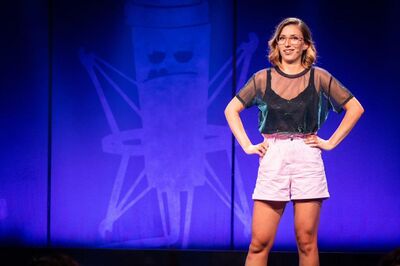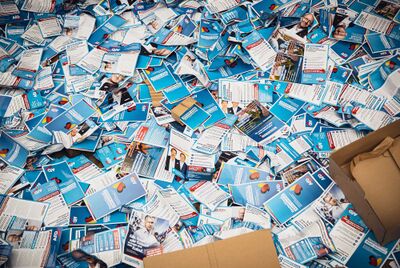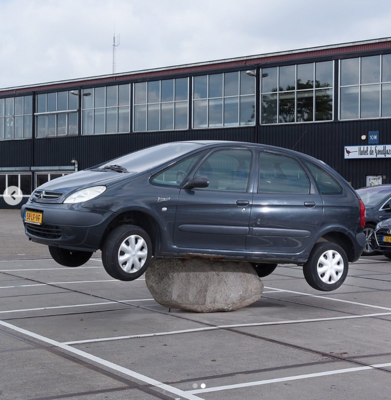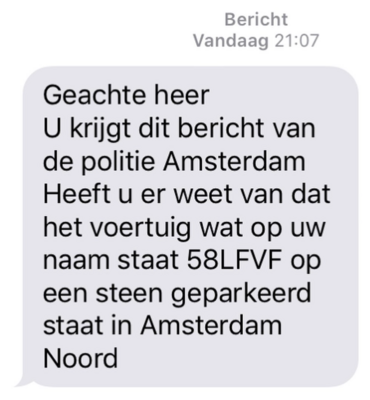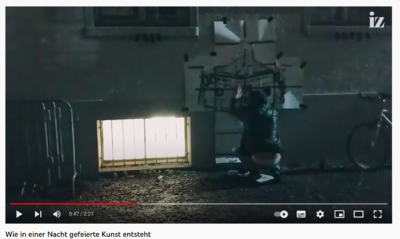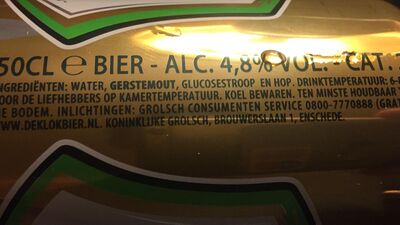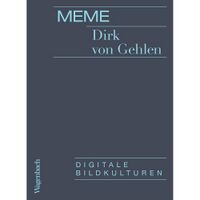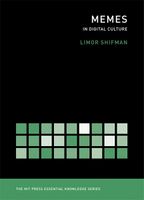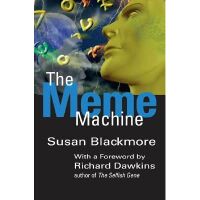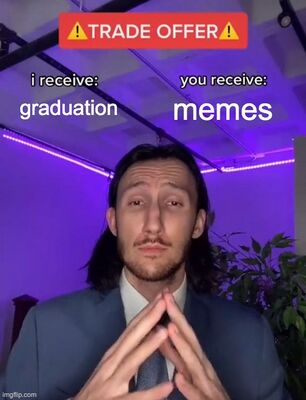Miri's XPUB2 proposal draft: Difference between revisions
Mirischoeb (talk | contribs) |
Mirischoeb (talk | contribs) |
||
| (19 intermediate revisions by the same user not shown) | |||
| Line 3: | Line 3: | ||
This master project is closely linked to my master thesis and therefore has the same research question: | This master project is closely linked to my master thesis and therefore has the same research question: | ||
'''What are the possibilities of translating memes into | '''What are the possibilities of translating memes into artistic infiltrations of the public sphere?''' | ||
So, I want to research the possibilities of memetic strategies for artistic interventions in public | So, I want to research the possibilities of memetic strategies for artistic interventions in the public sphere and the potential of "memefying" daily life. | ||
| Line 28: | Line 28: | ||
So for my project, I want to examine meme patterns and memetic behaviour and translate them to interventions in public spaces (operate artistically in a non-art context). My goal is to make a '''"guide to memefy your life"'''. This could be seen as a sort of manifesto for imaginary interventions that possibly could be realised by the reader as well as a collection of experiments and interventions I realised. My thesis research will help me analyse memes theoretically to receive a certain set of rules that could be applied to | So for my project, I want to examine meme patterns and memetic behaviour and translate them to interventions in public spaces (operate artistically in a non-art context). My goal is to make a '''"guide to memefy your life"'''. This could be seen as a sort of manifesto for imaginary interventions that possibly could be realised by the reader as well as a collection of experiments and interventions I realised. My thesis research will help me analyse memes theoretically to receive a certain set of rules that could be applied to infiltrations of public space/public sphere. | ||
While the '''"guide to memefy your life"''' will have the format of a handbook, the format of the interventions is a performative one. Next to this handbook, I will document my interventions on camera and this | While the '''"guide to memefy your life"''' will have the format of a handbook, the format of the interventions is a performative one. Next to this handbook, I will document my interventions on camera and this will lead me to make a '''short documentary''' about it as well. To find out what interventions exactly I will do, I first need to find out how one could translate a digital meme into an action and therefore, I am dependent on my thesis research. | ||
[[File:Idont.jpg|400x400px|frameless]] | |||
'''What exactly do I want to translate about the memes?''' | |||
Mostly, I want know, what makes a meme successful and translate these strategies of virality to actions. | |||
I think part of the viral success of memes is the part of the replication. An image that stands alone is not a meme but just an image. As long as something is not passed on to others through imitation, it can never become a meme. So if I want actions to become memes, I have to think about how the process of replicating could be done, too. | |||
Also, it will probably be inevitable to not bring in the comical part of internet memes since I like to work with humour. Nevertheless, it will not be the main thing I will "translate", since there might not be a translation needed, but rather just applying humour to the actions. | |||
| Line 42: | Line 51: | ||
[[File:WhatsApp Image 2022-11-18 at 15.22.51.jpg|200x200px|frameless]] | [[File:WhatsApp Image 2022-11-18 at 15.22.51.jpg|200x200px|frameless]] | ||
I mimicked and enlarged the design of the chocomel can and made a sticker out of it so it fits on a beer can. Because of the mimicking and the possibility of putting or using it in public space, in a way, this is already a similar process as the one that memes go through, nevertheless, the part of the collective replicating is missing. I want to explore how it could be possible that other people actually take part in | I mimicked and enlarged the design of the chocomel can and made a sticker out of it so it fits on a beer can. Because of the mimicking and the possibility of putting or using it in public space, in a way, this is already a similar process as the one that memes go through, nevertheless, the part of the collective replicating is missing. I want to explore how it could be possible that other people actually take part in an artistic infiltration through mimicking, just how they do it on the internet. | ||
==Why do you want to make it?== | ==Why do you want to make it?== | ||
| Line 64: | Line 73: | ||
Seeing this theoretical connection between these two topics (1. memes and 2. infiltrations of public spaces), made me want to research the possibilities of a literal translation from digital memes to actions. I want to find out how exactly this translation could be done and what political impact it would have on the public space as well as on the meme itself. Also, I want to find out about the potential of bringing memes to the street and the political dimension it could open up. The possibilities of memefying life in a non-digital way as pleasant disturbances, as a political voice or even as an act of non-violent protest. I want know, what advantages or disadvantages the digital or the non-digital sphere for the medium meme could have. | Seeing this theoretical connection between these two topics (1. memes and 2. infiltrations of public spaces), made me want to research the possibilities of a literal translation from digital memes to actions. I want to find out how exactly this translation could be done and what political impact it would have on the public space as well as on the meme itself. Also, I want to find out about the potential of bringing memes to the street and the political dimension it could open up. The possibilities of memefying life (maybe) in a non-digital way as pleasant disturbances, as a political voice or even as an act of non-violent protest. I want know, what advantages or disadvantages the digital or the non-digital sphere for the medium meme could have. | ||
Working in all kinds of public spaces fascinates me because it is inherently connected to claiming space back. Every public space is potentially an artistic space and every artistic space is political. How can you grasp and react to a place's political, cultural and national systems of values? To whom belongs space and how do you use it? How do you generate political participation and attention? How can you maybe even initiate social-transformatory processes through artistic interventions? These are questions that interest me in my practice of making things public. | Working in all kinds of public spaces fascinates me because it is inherently connected to claiming space back. Every public space is potentially an artistic space and every artistic space is political. How can you grasp and react to a place's political, cultural and national systems of values? To whom belongs space and how do you use it? How do you generate political participation and attention? How can you maybe even initiate social-transformatory processes through artistic interventions? These are questions that interest me in my practice of making things public. | ||
| Line 86: | Line 95: | ||
Questions like: How can a meme generate political participation? How do memes influence politics? What makes a meme successful? What characteristics make a meme spread faster? will help me define a certain set of characteristics I can apply to non-digital memes. In the last chapter, I will try to find out how exactly it could be possible to memefy your life and hopefully find answers that later on can guide me through my master project. | Questions like: How can a meme generate political participation? How do memes influence politics? What makes a meme successful? What characteristics make a meme spread faster? will help me define a certain set of characteristics I can apply to non-digital memes. In the last chapter, I will try to find out how exactly it could be possible to memefy your life and hopefully find answers that later on can guide me through my master project. | ||
For the experimental research, I will keep experimenting with strategies of mimicking and replicating. Hackpacts are a good way to experiment. I know that I work the best when I implement ideas as fast as quickly and then reflect afterwards. My starting point is often a "You know what would be funny?"-approach and then I just do it. I will observe what happens when you put a slightly altered object back into its original context and reflect on what is happing artistically and politically. | For the experimental research, I will keep experimenting with strategies of mimicking and replicating. Hackpacts are a good way to experiment. I know that I work the best when I implement ideas as fast as quickly and then reflect afterwards. My starting point is often a "You know what would be funny?"-approach and then I just do it. I will observe what happens when you put a slightly altered object back into its original context and reflect on what is happing artistically and politically. Also, I want to look into advertising strategies to find out how it could possibly be done that my actions (my memes) spread in the sense of being replicated. This could for example be done through the use of hashtags. | ||
| Line 113: | Line 122: | ||
* Hackpacts and experiments | * Hackpacts and experiments | ||
* 2 Dec - Deadline First Chapter | * 2 Dec - Deadline First Chapter | ||
* Thesis: Reading about public space | * Thesis: Reading about public space vs. public sphere | ||
* Thesis: Start writing on second chapter - Personal deadline: 31.12.2022 | * Thesis: Start writing on second chapter - Personal deadline: 31.12.2022 | ||
* Sum up: What makes a meme successful and what characteristics make it spread faster? | * Sum up: What makes a meme successful and what characteristics make it spread faster? | ||
| Line 168: | Line 177: | ||
*...Florian Cramer | *...Florian Cramer | ||
*...Benjamin Gaulon | *...Benjamin Gaulon | ||
*...Geert Lovink | |||
Thesis: | Thesis: | ||
| Line 179: | Line 189: | ||
*...help me documenting my interventions on camera | *...help me documenting my interventions on camera | ||
*...give me video editing support | |||
*...give me programming support for publishing online | *...give me programming support for publishing online | ||
| Line 244: | Line 255: | ||
[[File:Opera calling opernhaus innen detail zuschauer 905.png|400x400px|frameless]] | [[File:Opera calling opernhaus innen detail zuschauer 905.png|400x400px|frameless]] | ||
"'Opera Calling' was an artistic intervention into the cultural system of the Zurich Opera. By means of audio bugs placed within the auditorium of the local opera house, the outside public is given access to the performances on stage. The performances are retransmitted to the public not through broadcasting, but by telephoning each person individually."<ref>[https://wwwwwwwwwwwwwwwwwwwwww.bitnik.org/o/]</ref> | "'Opera Calling' was an artistic intervention into the cultural system of the Zurich Opera. By means of audio bugs placed within the auditorium of the local opera house, the outside public is given access to the performances on stage. The performances are retransmitted to the public not through broadcasting, but by telephoning each person individually."<ref>[https://wwwwwwwwwwwwwwwwwwwwww.bitnik.org/o/]</ref> Mediengruppe Bitnik | ||
'''The Barbie Liberation Organization''' | '''The Barbie Liberation Organization''' | ||
| Line 301: | Line 312: | ||
Arkenbout, C. and Scherz, L. (2022). Critical Meme Reader II: Memetic Tacticality. Amsterdam: Institute of Network Cultures | Arkenbout, C. and Scherz, L. (2022). Critical Meme Reader II: Memetic Tacticality. Amsterdam: Institute of Network Cultures | ||
Bogost, I. (2022). The Age of Social Media Is Ending. [online] Available at: https://www.theatlantic.com/technology/archive/2022/11/twitter-facebook-social-media-decline/672074/ [Accessed 26 Nov. 2022] | Bogost, I. (2022). The Age of Social Media Is Ending. [online] Available at: https://www.theatlantic.com/technology/archive/2022/11/twitter-facebook-social-media-decline/672074/ [Accessed 26 Nov. 2022] | ||
| Line 331: | Line 340: | ||
Erickson, J.D. (1984). Dada, Performance, Poetry and Art. USA: Twayne publishers | Erickson, J.D. (1984). Dada, Performance, Poetry and Art. USA: Twayne publishers | ||
Christe MA, D.W.C. and Ritzen, H.H.P.M. (2021). The Manual of Modern Pataphysics - Vol. 1. Rotterdam: Platform P | |||
Cramer, F. (2013). Anti-Media - Ephemera on Speculative Arts. Amsterdam: Institute of Network Cultures, Rotterdam: naio10 publishers | |||
McCulloch, G. (2019). Because Internet - Understanding how language is changing. London: Vintage | |||
Delaure, M. and Fink, M. (2017). Culture Jamming - Activism and the art of cultural resistance. New York: New York University Press | |||
Firat, B.Ö. and Kuryel, A. (2011). Cultural Activism : Practices, Dilemmas, and Possibilities. Amsterdam and New York, NY : Rodopi | |||
=== People & artworks to research:=== | === People & artworks to research:=== | ||
| Line 352: | Line 371: | ||
* Tactical media | * Tactical media | ||
* Culture jamming | * Culture jamming | ||
* Adbusting | |||
* Hacking | * Hacking | ||
* Guerilla hacks | * Guerilla hacks | ||
| Line 361: | Line 381: | ||
* Public sphere vs. public space | * Public sphere vs. public space | ||
* The starting of the emoji | * The starting of the emoji | ||
[[File:Tradeoffer.jpg|400x400px|frameless]] | |||
Latest revision as of 14:31, 12 December 2022
What do you want to make?
This master project is closely linked to my master thesis and therefore has the same research question:
What are the possibilities of translating memes into artistic infiltrations of the public sphere?
So, I want to research the possibilities of memetic strategies for artistic interventions in the public sphere and the potential of "memefying" daily life.
My project should combine these three interests of mine:
Internet memes:
Internet memes have developed into a kind of new language, a new digital dialect, which can not only help us identify and understand new cultural trends, but that can also have a political effect. What superficially can be understood as nonsense or jokes can be a very accessible form of important political participation. Almost everyone who is a bit familiar with the internet and digital culture can in principle understand meme language and also potentially make memes. It is interesting to me how memes are based on a pretty universal collective humor and a shared knowledge of images as well as as an understanding of how their replication works.
Infiltrations of public spaces:
My whole field of interest and artistic practice is based on the concept of thinking of public spaces as stages, to look at their surroundings, their purposes, and perceive them as a place of open communication. When I say "stage", I do not (only) mean the traditional podium but "stage" as an abstract term for every place of (performative) happenings and actions, whether these are public outdoor and indoor spaces, the medial or the virtual space. I am interested in invading existing and functioning systems with their own rules and rhythms, to examine and criticise these rules and fathoming them out. I like to take things out of a specific context, change them a bit and put them back into their context and look at the outcome. These infiltrations of public spaces can work similar to pranks.
(Internet) Humour in general:
As a comedian, I am very interested in how (internet) humour works, what jokes actually are and how they can open up a political dimension, the role of the context in which the joke is made and how to step into a dialogue with the audience of a stage.
So for my project, I want to examine meme patterns and memetic behaviour and translate them to interventions in public spaces (operate artistically in a non-art context). My goal is to make a "guide to memefy your life". This could be seen as a sort of manifesto for imaginary interventions that possibly could be realised by the reader as well as a collection of experiments and interventions I realised. My thesis research will help me analyse memes theoretically to receive a certain set of rules that could be applied to infiltrations of public space/public sphere.
While the "guide to memefy your life" will have the format of a handbook, the format of the interventions is a performative one. Next to this handbook, I will document my interventions on camera and this will lead me to make a short documentary about it as well. To find out what interventions exactly I will do, I first need to find out how one could translate a digital meme into an action and therefore, I am dependent on my thesis research.
What exactly do I want to translate about the memes?
Mostly, I want know, what makes a meme successful and translate these strategies of virality to actions.
I think part of the viral success of memes is the part of the replication. An image that stands alone is not a meme but just an image. As long as something is not passed on to others through imitation, it can never become a meme. So if I want actions to become memes, I have to think about how the process of replicating could be done, too.
Also, it will probably be inevitable to not bring in the comical part of internet memes since I like to work with humour. Nevertheless, it will not be the main thing I will "translate", since there might not be a translation needed, but rather just applying humour to the actions.
Example of translating memes into the public space:
I don't have a perfect example yet, since I still need to research more about these topics in order to make a good translation. One thing I can already say is that I will not just make internet memes as you know them and hang them in public space but I will actually try to transform memes into actions. A meme is not a meme on its own but works through imitation and collective replication. A hackpact I did during the GRS for this project is for example a replication of a chocomel sticker:
I mimicked and enlarged the design of the chocomel can and made a sticker out of it so it fits on a beer can. Because of the mimicking and the possibility of putting or using it in public space, in a way, this is already a similar process as the one that memes go through, nevertheless, the part of the collective replicating is missing. I want to explore how it could be possible that other people actually take part in an artistic infiltration through mimicking, just how they do it on the internet.
Why do you want to make it?
If you look further into the theories of memetics such as Richard Dawkins theories in The Selfish Gene, you quickly find out that memes do not only refer to internet memes but in a broader way, to elements of behaviour passed on from one individual to another by imitation (such as jokes, songs, dances or even beliefs that have been passed on over generations). Dawkins refers to memes as the cultural parallel to biological genes in the sense of that they are similar in being in control of their own reproduction.
When reading into this, I could not unsee the parallels between memetic strategies and art strategies I've researched and used in the past. Tactical media, culture jamming, hacking strategies and media activism often work similar to memes. Such parallels are:
- Working bottom-up (meaning they proceed from the bottom of a hierarchy upwards)
- Replicating something with a twist (taking something out of a context, changing it a bit and putting it back into this context)
- Easy generation of attention and participation
- The aspect of humour
- The use of public space
- The use of an audience
- Being part of a community
These parallels certainly do not apply to all the projects of these art movements and are clearly my own perception, nevertheless, they apply strongly to my own artistic practice.
Seeing this theoretical connection between these two topics (1. memes and 2. infiltrations of public spaces), made me want to research the possibilities of a literal translation from digital memes to actions. I want to find out how exactly this translation could be done and what political impact it would have on the public space as well as on the meme itself. Also, I want to find out about the potential of bringing memes to the street and the political dimension it could open up. The possibilities of memefying life (maybe) in a non-digital way as pleasant disturbances, as a political voice or even as an act of non-violent protest. I want know, what advantages or disadvantages the digital or the non-digital sphere for the medium meme could have.
Working in all kinds of public spaces fascinates me because it is inherently connected to claiming space back. Every public space is potentially an artistic space and every artistic space is political. How can you grasp and react to a place's political, cultural and national systems of values? To whom belongs space and how do you use it? How do you generate political participation and attention? How can you maybe even initiate social-transformatory processes through artistic interventions? These are questions that interest me in my practice of making things public.
The topic of how to invade (or in other words: to hack) existing functioning systems keeps me busy. When you operate artistically in a non-art context you reach a different audience you can step into dialogue with. It can shift existing hierarchies and be a way of voicing political opinions.
Connected with a humorous approach, these infiltrations of public also spaces remind me also lot of the concept of pranks and other kinds of internet humor which obviously fit to my practice as well. I have mentioned that I like to think of public spaces as stages. Surely, the obsession with stages also comes from my background as a slam-poet, comedian and performance artist, since next to my studies, I've been performing regularly on podiums for seven years now. My comedy background is inherently connected to my artistic practice since the starting points of my projects often come from trying to find humorous approaches to solve problems in daily life, point out the absurdities in our daily life or to mock the status quo. I am interested in art works that function like a joke, like a punchline, but that – just like good comedy – can open up a political discussion. I believe that through humour, politics can be more accessible.
All these reasons are why I want to research the possibilities of memetic strategies for artistic interventions and the potential of "memefying" daily life.
How do you plan to make it?
I want to combine doing research and experimenting along the process. The theoretical research will include reading into meme history and theories, internet culture, hacking strategies, media activism, culture jamming, drop lifting, tactical media, etc. (see: references and bibliography). Since the master thesis is closely linked to my master project I hope the thesis will give me answers to the questions that arise in my own creative process. In my thesis, I will write about three topics:
- Memes and their political dimension
- Infiltration of public space as an art strategy
- The potential of memefying daily life
Questions like: How can a meme generate political participation? How do memes influence politics? What makes a meme successful? What characteristics make a meme spread faster? will help me define a certain set of characteristics I can apply to non-digital memes. In the last chapter, I will try to find out how exactly it could be possible to memefy your life and hopefully find answers that later on can guide me through my master project.
For the experimental research, I will keep experimenting with strategies of mimicking and replicating. Hackpacts are a good way to experiment. I know that I work the best when I implement ideas as fast as quickly and then reflect afterwards. My starting point is often a "You know what would be funny?"-approach and then I just do it. I will observe what happens when you put a slightly altered object back into its original context and reflect on what is happing artistically and politically. Also, I want to look into advertising strategies to find out how it could possibly be done that my actions (my memes) spread in the sense of being replicated. This could for example be done through the use of hashtags.
What is your timetable?
October
- Hackpacts and experiments
- Reading the book "Memes in digital culture" by Limor Shifman
November
- Hackpacts and experiments
- Make a reading list - What chapters of what books are the most useful?
- 18 November - Graduate Proposal Deadline
- 18 November - Thesis Outline Deadline
- Start writing on first chapter of the thesis and ask for feedback
- Sum up the most important points I found out during my research that are helpful for my master projects and apply them on hackpacts and experiments
- Thesis: Reading about memes
December
- Hackpacts and experiments
- 2 Dec - Deadline First Chapter
- Thesis: Reading about public space vs. public sphere
- Thesis: Start writing on second chapter - Personal deadline: 31.12.2022
- Sum up: What makes a meme successful and what characteristics make it spread faster?
January
- Hackpacts and experiments
- Thesis: Start writing on the third chapter - Personal deadline: 31.01.2023
- Making a mind map that connects thesis and project
- Know the outcome of the final project
- Make plan on how to document artistic interventions
- Borrow video equipment
February
- Start first interventions and document them
- Thesis: Write introduction and conclusion
- 17 Feb - Deadline First Draft Thesis
- Make a plan for the “guide to memefy life" (chapters, style, content)
March
- Thesis: Improve the thesis draft with the feedback I will have gotten
- 17 March - Deadline Second Draft thesis
- 31 March - Deadlines Second readers' comments
- Write on "guide to memefy your life"
- Keep on doing interventions and documenting them
April
- 14 April - DEADLINE THESIS
- Write on "guide to memefy your life"
- Research on where and how to print the guide
- Keep on doing interventions and documenting them
- Start with editing the video material
May
- Write on "guide to memefy your life"
- Keep on doing interventions and documenting them
- Finish layout of the "guide to memefy your life"
- Print "guide to memefy your life"
- Decide whether the video documentation will be part of the exhibition
June
- Know how I will exhibit the project
- Finalise project
- Graduation show
Who can help you and how?
Teachers that...
- ...know about hacking as an artistic practice
- ...are interested in social media phenomenons, internet humour (especially memes) and pop culture
- ...see the potential of working interdisciplinary beyond categories like art, design or comedy
- ...Florian Cramer
- ...Benjamin Gaulon
- ...Geert Lovink
Thesis:
- ...Lidia Pereira
Online stuff:
- ...Manetta Berends
- ...Joseph Knierzinger
Maybe other people that...
- ...help me documenting my interventions on camera
- ...give me video editing support
- ...give me programming support for publishing online
Stations:
- ...WDKA Rental station
- ...Print station
- ...other stations depending on what material i will be using
Relation to previous practice
In my Fine Arts & Design Bachelor, I already worked a lot in public spaces and experimented with the strategy of hacking. Examples I could mention are the following projects:
«US$ 2,81»
For my bachelor graduation project, I made stock photos of myself, uploaded them on Shutterstock and with the money I earned (US$ 2,81), I bought a "Young happy woman bachelor graduation"-stock image and exhibited it.
«Sorry, neighbour»
In my old apartment, the postman regularly brought packages that my neighbours ordered to my place when they were not at home. So I decided to modify them a bit.
«I bought this bag, painted it and brought it back to the store»
I bought a bunch of Albert Heijn bags, painted their insides and put them back into the store next to the self-checkout.
Video collective «Schild mit Lohn»
Schild mit Lohn is a trash video collective by Luisa Zürcher and me. Next to edited found footage made into meme-like videos, we also publish videos in which we intervene as heroes of the city and satirically save the world by, for example, stealing products from one supermarket and donate them to another one (episode 2: "Spendenaktion") burning snow to raise awareness for climate change (episode 3: "Weg mit dem Schnee") or standing as body guards in front of flower shops (episode 4: "Bluemelade").
Instagram: https://www.instagram.com/schildmitlohn/
«Reasons To Stay Home»
When the virus SARS-CoV-2 just entered the Netherlands and the parliament advised all citizens to stay home, I started the billboard series "Reasons To Stay Home". I tried to find funny reasons to stay home, wrote them on cardboard and hung a total of 31 billboards all over Nijmegen, the Netherlands.
De Gelderlander: https://www.gelderlander.nl/nijmegen/ook-met-positieve-teksten-kun-je-mensen-bewegen-om-thuis-te-blijven~a30ad0cf/
«Es goht gad öppis ume.»
I stole the design of the Swiss Government's Corona campaign and edited the text to "Es goht gad öppis ume" (engl: "Something is going around at the moment"). "Es goht gad öppis ume" is the standard answer of a Swiss person when you tell them that you are a bit sick.
@xpubmemes
Since I love memes, I started a meme account for XPUB on instagram.
Instagram: https://www.instagram.com/xpubmemes/
Comedy/Poetry Slam Background
Since 7 years I perform as a comedian, slam poet, writer and event host on stages. Also, I am a member of the Swiss satire platform "Petarde".
Petarde: https://petarde.ch/
Relation to a larger context
Art projects I like
Opera Calling
"'Opera Calling' was an artistic intervention into the cultural system of the Zurich Opera. By means of audio bugs placed within the auditorium of the local opera house, the outside public is given access to the performances on stage. The performances are retransmitted to the public not through broadcasting, but by telephoning each person individually."[1] Mediengruppe Bitnik
The Barbie Liberation Organization
The Barbie Liberation Organization switched the voice boxes of G.I.Joe and Barbie dolls and put them back in the store.
Kim Kierkegaardashian:
"Kim Kierkegaardashian posts tweets combining the writings of nineteenth-century existentialist philosopher Søren Kierkegaard with tweets from influencer Kim Kardashian West. The unnamed person behind the iconic Twitter account is also a published author, and recent New Yorker advice columnist."[4]
Flyerservice Hahn
The collective "Zentrum für politische Schönheit" founded a fictional flyer logistics company and convinced the German right-wing party AFD to distribute all the flyers of their political campaign for them. Instead of distributing their fascist propaganda, they shredded all their flyers.
Picasso 2019
Installation by Bart Eysink Smeets
Social media
Wie in einer Nacht gefeierte Kunst entsteht (engl.: How to make popular art in one night)
The Swiss social media magazine Izzy is known for funny pranks in public space. In 2019, they faked a Banksy graffiti in the same night a Banksy exhibition took place in Zurich and made the public think that the city has a Banksy work now. After the whole public spectacle of media reporting about it and the city protecting the work, they unraveled the truth.
Other
Klok beer
Klok is one of the cheapest beers that you can buy in the Netherlands and is very popular among students. There is this running gag saying "Een man van cultuur drinkt zijn Klok op kamertemperatuur." (engl.: "A man of culture drinks his Klok at room temperature"). The joke became so popular that they incorporated it in the design now. They stated on the beer can: "Voor de liefhebbers op kamertemperatuur" (engl.: "For the enthousiasts at room temperature"). It is interesting to me how this meme became a part of the advertising strategy.
References
Bibliography
Shifman, L. (2014). Memes in Digital Culture. Cambridge: MIT Press
Blackmore, S. and Dawkins, R. (1999). The Meme Machine. New York: Oxford University Press
Von Gehlen, D. (2020). Meme. Berlin: Verlag Klaus Wagenbach
Christe MA, D.W.C. and Ritzen, H.H.P.M. (2021). The Manual of Modern Pataphysics - Vol. 1. Rotterdam: Platform P
Raley, R. (2009). Tactical media. Minnesota: University of Minnesota Press
Arkenbout, C. and Scherz, L. (2022). Critical Meme Reader II: Memetic Tacticality. Amsterdam: Institute of Network Cultures
Bogost, I. (2022). The Age of Social Media Is Ending. [online] Available at: https://www.theatlantic.com/technology/archive/2022/11/twitter-facebook-social-media-decline/672074/ [Accessed 26 Nov. 2022]
Weibel, P. (2015). Global Activism, Art and Conflict in the 21st Century. Cambridge: MIT Press
Friesinger, G. and Grenzfurthner J. and Ballhausen, T. (2010). Urban Hacking: Cultural Jamming Strategies in the Risky Spaces of Modernity. Bielefeld: Transcript publishing
Schmidt, S.M. (2010). Hacking the City, Interventions in urban and communicative spaces. Folkwang: Edition Folkwang / Steidl
Christe, D.W.C. and Ritzen, H.H.P.M. (2021), The Manual of Modern Pataphysics. Rotterdam: Platform P
Stiegler C. and Breitenbach P. and Zorbach T. (2015). New Media Culture: Mediale Phänomene der Netzkultur. Bielefeld: transcript publishing
Nowotny J. and Reidy J. (2022). Memes, Formen und Folgen eines Internetphänomens. Bielefeld: transcript publishing
Marrs, L. and & Dingsun, T. (2022). How to Read the Internet. [online] Available at: https://otherinter.net/research/lore/how-to-read-the-internet/ [Accessed 26 Nov. 2022]
Hemmens, A. and Zacarias G. (2020). The Situationist International, A Critical Handbook. Pluto Press
Cramer, F. (2017). Meme Wars: Internet Culture and the ‘Alt Right’. FACTLiverpool [online] Available at: https://www.youtube.com/watch?v=OiNYuhLKzi8&ab_channel=FACTLiverpool [Accessed 17. Nov. 2022]
Jones, S.E. (2006). Against Technology - From the Luddites to Neo-Luddism. Great Britain: Routledge
Deseriis, M. (2011). Lots of Money Because I am Many: The Luther Blissett Project and the Multiple-Use Name Strategy. Books.google.com
Baas, J. (2011). Fluxus and the Essential Questions of Life. New Hampshire: Hood Museum of Art, and Chicago: The University of Chicago Press
Erickson, J.D. (1984). Dada, Performance, Poetry and Art. USA: Twayne publishers
Christe MA, D.W.C. and Ritzen, H.H.P.M. (2021). The Manual of Modern Pataphysics - Vol. 1. Rotterdam: Platform P
Cramer, F. (2013). Anti-Media - Ephemera on Speculative Arts. Amsterdam: Institute of Network Cultures, Rotterdam: naio10 publishers
McCulloch, G. (2019). Because Internet - Understanding how language is changing. London: Vintage
Delaure, M. and Fink, M. (2017). Culture Jamming - Activism and the art of cultural resistance. New York: New York University Press
Firat, B.Ö. and Kuryel, A. (2011). Cultural Activism : Practices, Dilemmas, and Possibilities. Amsterdam and New York, NY : Rodopi
People & artworks to research:
- The Barbie Liberation Organization (art work: switched voice boxes in talking G.I. Joes and Barbie dolls)
- Collective IOCOSE - Sokkomb (art work: Ikea guillotine)
- !Mediengruppe Bitnik (uses the strategy of hacking)
- Zentrum für politische Schönheit (uses the strategy of hacking)
- Peng! Collective (uses the strategy of hacking)
- Shawn Huckins (combines text taken from the internet with classical painting)
- Kim Kierkegaardashian (Twitter account. Mashup of the nineteenth-century existentialist philosopher Søren Kierkegaard and the reality star Kim Kardashian West)
- Bart Eysink Smeets (humour and advertising strategies)
- Izzy Magazine (social media magazine that works with pranks a lot)
- Luther Blissett (multiple-use name used by activists)
- Florian Cramer (writer and theoriest at WDKA)
- Geert Lovink (Head of Institute for Network Culture)
- Jürgen Habermas (public sphere)
Other keywords to research:
- Retail poisoning
- Drop lifting
- Tactical media
- Culture jamming
- Adbusting
- Hacking
- Guerilla hacks
- Luddism
- Ned & Eliza Ludd
- International situationists
- Dada
- Fluxus
- Public sphere vs. public space
- The starting of the emoji

